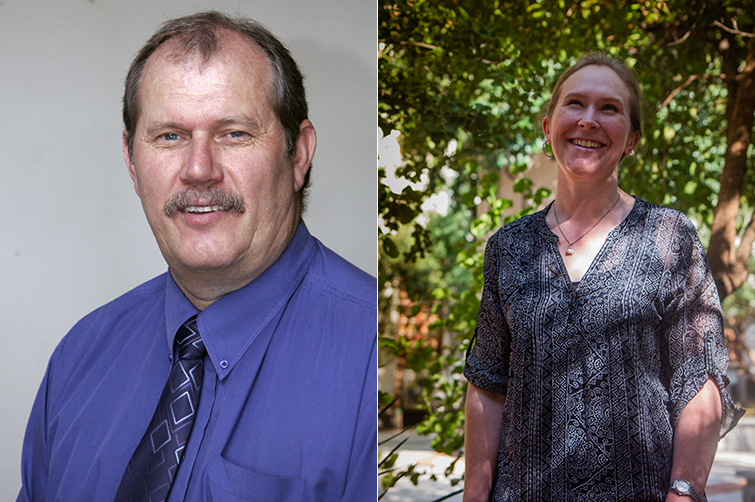25 April 2022
|
Story Elsabé Brits
 Prof Andreas Roodt and Prof Alice Brink are two of the inventors of the ‘Multinuclear complexes and their preparation patent.
Prof Andreas Roodt and Prof Alice Brink are two of the inventors of the ‘Multinuclear complexes and their preparation patent.
According to the World Health Organisation (WHO), cancer is a leading cause of death worldwide, accounting for nearly 10 million deaths in 2020, or nearly one in six. The most common cancers are breast, lung, colon, rectum, and prostate cancers. There is a constant need to provide methods to diagnose and treat cancer-related tumours. Current research strategies focus on eliminating cancer cells with the minimum damage to surrounding healthy cells.
A limitation of current technologies is that they are mostly based on the separate identification of cancer (diagnostic), followed by treatment (therapy) using chemotherapy and/or radiotherapy. To fit both needs at the same time and with similar or identical compounds, the principle of theranostic medicine was identified. This concept employs both diagnosing (by imaging) cancer and delivering therapy (treatment) simultaneously, which has been receiving increased attention internationally.
Collaborating with the University of Zurich
A University of the Free State (UFS) team, together with a team from the University of Zürich, conducted exciting research in this area and filed a patent titled ‘Multinuclear complexes and their preparation’. The patent was granted in South Africa and by the European Patent Office. It is being validated in selected European countries. The patent is pending in the USA, Japan, Hong Kong, and India. The inventors from the UFS are Prof Andreas Roodt, Prof Alice Brink, Dr Pennie Mokolokolo, and Dr Vincent Dumisani Kama. The approach that their technology takes is to enable the synthesis of a multinuclear compound/s, which may contain different pre-selected radioisotopes, to allow both imaging and therapy to the cancer site(s) with one and the same metal-organic complex.
So far, high-yield production of compounds has been successfully innovated, which contain both an imaging (in particular the widely utilised imaging isotope Technetium-99m) and therapeutic (typically the therapeutic isotope Rhenium-186) radioactive isotope(s), optionally carrying an additional cytotoxic agent. (Chemotherapy uses anti-cancer [cytotoxic] drugs to destroy cancer cells.)
Nuclear medicine technologies
In the next phase of the research, a lead compound portfolio of four to five model pharmaceuticals containing these metal nuclides with appropriate directing groups to target cancer sites will be designed and constructed. A number of these entities are known and can be introduced through different techniques. These will then undergo full characterisation and efficacy evaluation in biological models (in vitro), followed by extensive animal and human trials.
The technology will be delivered as a product or service in the way that current nuclear medicine technologies are delivered.
The fact that this product(s) contains both imaging and therapeutic radionuclides or cytotoxic modalities, enables detailed tracking of the pharmaceutical and monitoring of the tumours' response to the therapy. Not directly related to the patent, but an asset to it, is the fact that the incorporation of rhenium with a high atomic number (Z = 75) opens the additional opportunity to utilise the multinuclear compounds also as radiosensitisers. Synergistic effects, enhancing the therapeutic efficacy, can thus be expected in combination with radiotherapy.
The UFS would like to partner with a pharmaceutical company working in the field of nuclear medicine to commercialise this technology. Interested parties can contact Ravini Moodley at MoodleyR5@ufs.ac.za